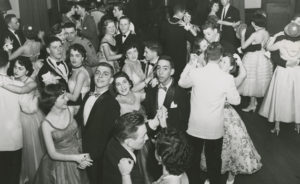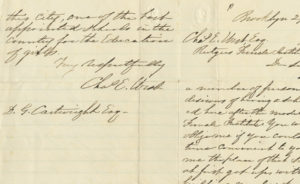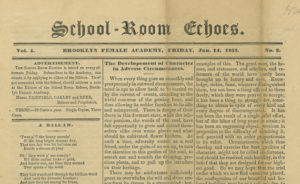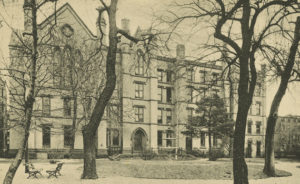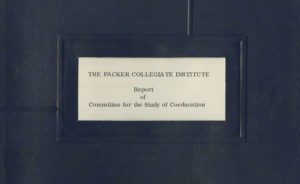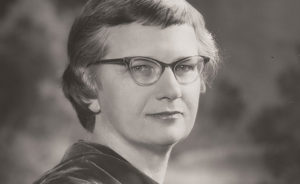The Packer Collegiate Institute: A Story of Education in Brooklyn
The Packer Class of 1950 and the Battle over the “Ideal Woman” and Her Future
Georgia Bank
“My school-girl crush disappeared and I had fallen in love with you,” wrote Linda, the main character in Frances Poggi’s “fictional” piece, published in the fall of 1949 in the Packer Current Items (PCI), about a student who marries her professor.

France Poggi, PCI, 1949; Packer Collegiate Institute records, 2014.019. Box 124, Folder 18; Brooklyn Historical Society.
Immediately following Frances’s piece is a work of nonfiction called, “Packer – One Hundred Years Ago,” by an author using the initials M.K. M.K. compared the opportunities available to women at Packer in the mid-twentieth century to their prospects when the Brooklyn Female Academy was founded in 1845. At the Brooklyn Female Academy, M.K. argued, that the “women’s [sic] brain were considered much too feeble to comprehend such subjects as Latin and Mathematics, but [noted that] this theory” was quickly disproved.

M.K., PCI, 1949; Packer Collegiate Institute records, 2014.019, Box 124, Folder 18; Brooklyn Historical Society.
In addition to this, she hoped that the quality of women’s minds would continue to become more accepted in the future. These stories portray two concurrent and seemingly contradictory views of young women in early post-War America.
Why did these two idealized images of women co-exist during the early post-War era? In the early 1940s, middle-class white women had just begun to go to work to replace the men who were fighting in WWII. However, even though women were needed to support their country, they still weren’t accepted in this new role: men often teased, “you can leave!” Once the men returned from the War and went back to work, many of these same women lost their economic opportunities and most of the emancipated women of the wartime era were pushed out of their jobs and were left feeling displaced in their own society again. Betty Furness, star of a 1950s kitchenware commercial for Westinghouse, helped ease these women back into the home. Confident in her bright kitchen, Furness showed women how easy and fun household chores could be.
This shift towards domesticity had an affect on the women in the New York region. Marriage forums created by Father Morgan in Nassau County showed the impact of efforts to return to prior notions of the ideal woman; the purpose of these forums was to influence single women to get married.

Set Marriage Forums To Aid Single Women, Brooklyn Eagle Newspaper, March 19, 1952, Digital Image, Brooklyn Eagle Online Archives, Brooklyn Public Library.
An article about these forums was published in the 1952 Brooklyn Eagle newspaper: the purpose of the forum, said Father Morgan, is “to restore to young people the sacred nature of marriage and the necessary link between fidelity and happiness.” The use of the word “restore” implied that these ideals that the forums were reinforcing for single women had previously existed.
In this context, young women’s feelings of displacement impacted their orientation towards the future. Betty Friedan noted that most women in college in this era had no plans for the future. In fact, the ones that were considered lucky were the girls who were already engaged because their futures were certain. The emerging anxiety among women caused many to question their fates. A “medical” question about menopause published in the Brooklyn Eagle newspaper directed to Dr. Brady showed how anxious women were about being single: “Menopause…. Is it more difficult for single women than it is for married women?” The fear and negativity projected by experts against non-traditional roles made women believe that being single would not only hurt them emotionally, but also physically.
During this transformation of the idealized woman from the 40s to early 50s, according to magazines like Seventeen and Look, men were more interested in younger and more feminine housewives. In contrast to government propaganda during the War, after World War II, media largely heightened the tension between notions of capable working woman and the delicate housewife. In this period, when women were being pushed towards domesticity, as the PCI articles suggest, the same tension existed. However, this push towards the domestic role for women slowly deteriorated. While domesticity does reemerge post World War II in Westinghouse commercials, magazines, and other media, it was only temporary. As seen through the fourteen Alumni Questionnaires taken from the Packer class of 1950 over a span of two time periods, 1966 and 1984, women began to go back to school and obtain full-time employment. For example, in 1966 none of the women worked full-time and only one went back to college. Whereas by 1988, eight women worked full time and five went back to college. Beginning with women entering the workforce in substantial numbers in World War II, the dominance of the domestic role reoccurred but this eventually deteriorated. The trend M.K. observed of women becoming more accepted for their intellect continued.
May 2017

Sarony Studio, Frances Poggi, 1950, digital image, Frances Poggi Album, Ancestry.com.
